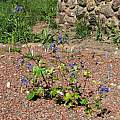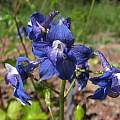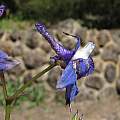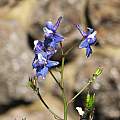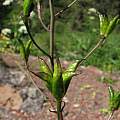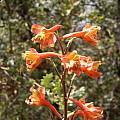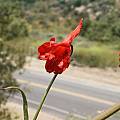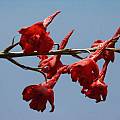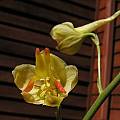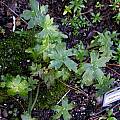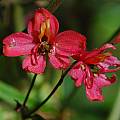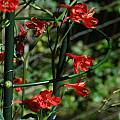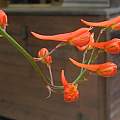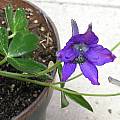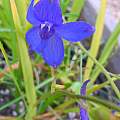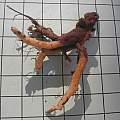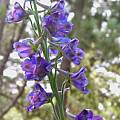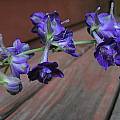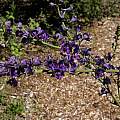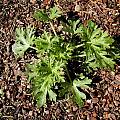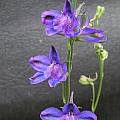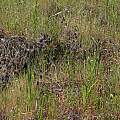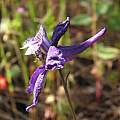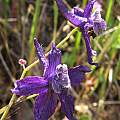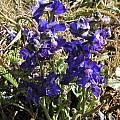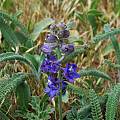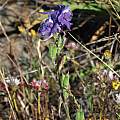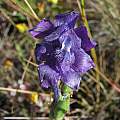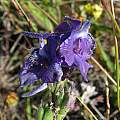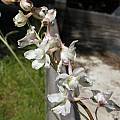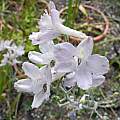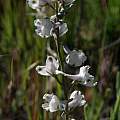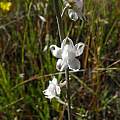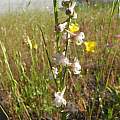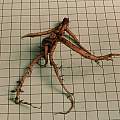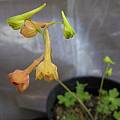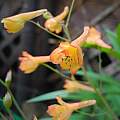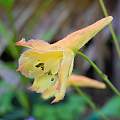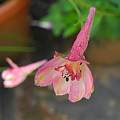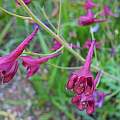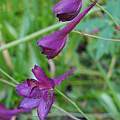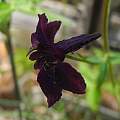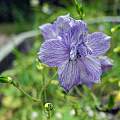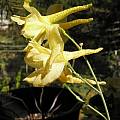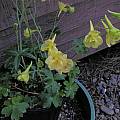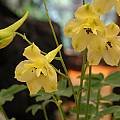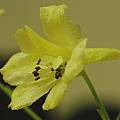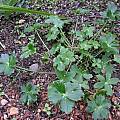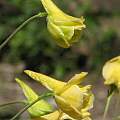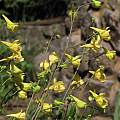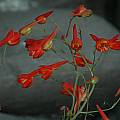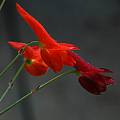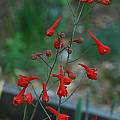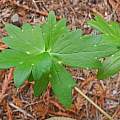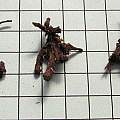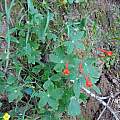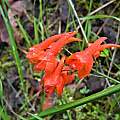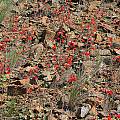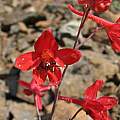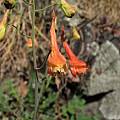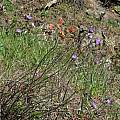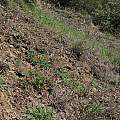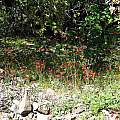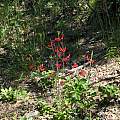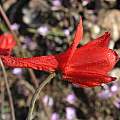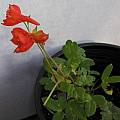Delphinium species a-n are found on this wiki page
Delphinium bakeri Ewan is an endangered species now known only from one remaining tiny population near Salmon Creek in Sonoma County, where only seven plants remained as of March 2006. In two years from 2002-2004 a population of about 100 plants was driven to near extinction by county-hired road crews mowing weeds, clearing roadside clogs using heavy machinery, and controlled burns. Due to the conservation efforts of Holly Forbes at the UC Botanical Garden, flowering plants have been reintroduced into the wild and they can be seen in Bay Area botanical gardens. Height: to about 65 cm. The photos below were taken by Nhu Nguyen at the Tilden Botanic Garden.
Delphinium cardinale Hook. is a tall species (to 6 feet) that grows from deep woody roots found on hot slopes near chaparral in southern California. It blooms in summer and bears bright red, (occasionally yellow)long-spurred flowers. These photos were taken by John Ingram of a wild population.
The first photo below by Bob Rutemoeller is of a yellow flowered one that appeared in a group of seedlings and is growing in a garden in Northern California. The second photo shows the leaves of one that was planted out and survived a couple of years before it disappeared. The new leaves were eaten showing the necessity of protection from birds and snails and slugs. The next two pictures show flowers of one that at least the first year seems happy growing in a large container sunk in a raised bed and supported. The last photo shows another plant flowering the second year after being grown from seed. The last four photos were taken by Mary Sue Ittner
Delphinium decorum Fisch. & C.A.Mey. is a short species with dark blue purple flowers that grow from tuberous roots and is found in grassy coastal areas in California and southern Oregon. It has shiny leaves that are not as dissected as some species and is very hairy. Height range: 35-40 cm. Photos by Mary Sue Ittner. The last shows the roots on a 1 cm grid.
Delphinium hansenii (Greene) Greene is found on oak woodland or open chaparral in central California in a wide range of elevations. It has a short slender root with large basal leaves that are barely divided and dark blue-purple to bluish or reddish flowers, sometimes white in a dense spike. Height range: between 2-6 ft.
Delphinium hansenii subsp. hansenii is found in oak woodland and has dark blue-purple to white or pink flowers. Photos by Bob Rutemoeller and Mary Sue Ittner. Grown from Northwest Native Seeds 00-216, it was planted in the ground instead of a container and was very tall with many more flowers. It flowered in summer, but eventually disappeared.
Delphinium hesperium A.Gray is a white to pinkish or dark blue-purple species that grows from a rootstock. It has narrowly divided leaves with shiny green divisions. Found in grassland and open woodlands this is predominantly a species of northwestern California. Height range: 1-4 ft. Photos 1-2 by Mary Sue Ittner show the basal leaves of a garden plant, and a close-up of the flowers. Photos 3-5 were taken by Nhu Nguyen at Mount Diablo State Park.
Delphinium hesperium subsp. hesperium has dark blue purple flowers. Photos 1-2 were taken by Bob Rutemoeller on the Mendocino Sonoma Coast at Hearn Gulch where it grows overlooking the ocean. Photos 3-5 were taken by Nhu Nguyen on Ring Mountain, Marin Co., CA.
Delphinium hesperium subsp. pallescens (Ewan) F.H.Lewis & Epling known as the pale flowered western larkspur is found in oak woodland and eastern slope coast ranges of California from 20 to 1000 m. It has spreading sepals and white to pink or light blue flowers from March to May. The first two photos are of plants grown from seed. The next three photos were taken along Bear Valley Road of plants growing in the grassy bank above the road with Calochortus luteus May 2016. Photos from Bob Rutemoeller and Mary Sue Ittner. The last photo shows the roots on a 1 cm grid.
Delphinium hybrids often appear if one than one species is grown close to another. Below are some of what she believes to be hybrids.
The photos below she suspects are hybrids between Delphinium nudicaule and Delphinium luteum. These two species have been known to hybridize. Photos from Mary Sue Ittner
Some of these probably have Delphinium nudicaule in their heritage.
Delphinium luteum A.Heller is a very rare species found in only two places on the coastal bluffs of Sonoma County California. It very closely resembles Delphinium nudicaule except it has yellow instead of orange red flowers. It has a distally branched rootstock and mostly basal leaves and is a short species about a foot tall. Height: to about 55 cm. Photos 1-2 were taken by Mary Sue Ittner. Photo 2 shows the basal leaves before flowering.
The photos below were taken by Nhu Nguyen at the Tilden Botanic Garden.
Delphinium nudicaule Torr. & A.Gray is found in a broad area of Northern California, Central Western California and Oregon on moist wooded, rocky slopes. It has a distally branched rootstock and scarlet to orange-red flowers and grows from one to two feet. This species is pollinated by hummingbirds and hybridizes with other delphiniums in its range. In a wild population there was a very dark red flower in the middle of the orange-red ones. It could have been a hybrid although I didn't see another species around. I marked it and came back later and saved seed. Most of the seedlings from that plant retained the dark red color. The first three photos were taken by Mary Sue Ittner. Photo 2 shows the darker flower with the usual color. Photo 3 shows the plant blooming well in a container sunk in a raised bed where the soil remains moist longer than in the ground.
The first three photos from Bob Rutemoeller and Mary Sue Ittner are of plants flowering along a county road in Sonoma County, California. The next two photos were taken by Nhu Nguyen of a population growing on serpentine talus near Mt. Hamilton, Santa Clara Co, CA.
The photos below taken by Nhu Nguyen. Photos 1-3 show an orange form growing on a hillside in Napa Co., CA. Photos 2-3 show the plants growing with Dipterostemon capitatus (syn. Dichelostemma capitatum). Photos 4-6 show plants growing on top of Mount Diablo in northern CA. This population has bright red flowers with small and succulent leaves. The area receives snow every winter so the growing season is later than those at lower altitudes.
Delphinium nudicaule 'Laurin' This plant was purchased at a nursery and described as more compact with better branching. They suggested with dead heading it would bloom all summer when the species is a winter growing plant dormant in summer. If kept wet it will stay growing, but over time it behaved a bit more like the species. Photo from Mary Sue Ittner.
Delphinium index - Delphinium species o-z
